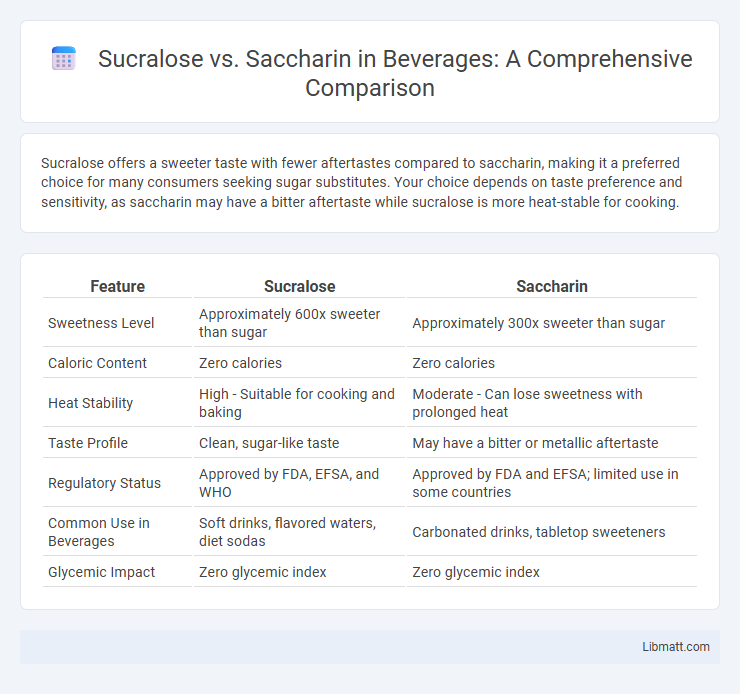Sucralose offers a sweeter taste with fewer aftertastes compared to saccharin, making it a preferred choice for many consumers seeking sugar substitutes. Your choice depends on taste preference and sensitivity, as saccharin may have a bitter aftertaste while sucralose is more heat-stable for cooking.
Table of Comparison
| Feature | Sucralose | Saccharin |
|---|---|---|
| Sweetness Level | Approximately 600x sweeter than sugar | Approximately 300x sweeter than sugar |
| Caloric Content | Zero calories | Zero calories |
| Heat Stability | High - Suitable for cooking and baking | Moderate - Can lose sweetness with prolonged heat |
| Taste Profile | Clean, sugar-like taste | May have a bitter or metallic aftertaste |
| Regulatory Status | Approved by FDA, EFSA, and WHO | Approved by FDA and EFSA; limited use in some countries |
| Common Use in Beverages | Soft drinks, flavored waters, diet sodas | Carbonated drinks, tabletop sweeteners |
| Glycemic Impact | Zero glycemic index | Zero glycemic index |
Introduction to Sucralose and Saccharin
Sucralose and saccharin are popular artificial sweeteners used in food and beverages to provide sweetness without calories. Sucralose is derived from sucrose by selectively chlorinating the sugar molecule, making it approximately 600 times sweeter than sugar, while saccharin is one of the oldest artificial sweeteners, roughly 300 to 400 times sweeter than sugar and synthesized through a chemical reaction involving o-sulfobenzoic acid. Both compounds are widely used in sugar-free products, but they differ significantly in chemical structure, taste profile, and stability under heat.
Chemical Structures and Origins
Sucralose is a chlorinated derivative of sucrose, where three hydroxyl groups are replaced by chlorine atoms, resulting in a non-caloric sweetener originally synthesized in 1976. Saccharin, discovered in 1879, is a sulfonamide compound with a benzisothiazole chemical structure, known for its intense sweetness and lack of calories. Both artificial sweeteners differ significantly in molecular composition and source, impacting their taste profile and stability in various applications.
Sweetness Comparison
Sucralose is approximately 600 times sweeter than sucrose, making it significantly sweeter than saccharin, which is about 300 to 400 times sweeter than sucrose. Sucralose has a cleaner, sugar-like taste with less bitterness, whereas saccharin often carries a bitter or metallic aftertaste, especially at higher concentrations. This sweetness profile makes sucralose more preferred in beverages, baked goods, and processed foods for a natural sugar substitute.
Calorie Content and Weight Management
Sucralose contains zero calories, making it a popular choice for weight management and calorie-conscious individuals, whereas saccharin also has no calories but may have a slightly bitter aftertaste that affects taste preferences. Studies indicate that sucralose does not impact blood sugar levels, supporting its use in low-calorie and diabetic diets, while saccharin has been associated with varying effects on appetite regulation. Both sweeteners provide a sugar-free alternative, aiding in weight control by reducing overall caloric intake when substituted for sugar.
Metabolism and Digestive Differences
Sucralose is minimally metabolized by the body, as it passes through the digestive system largely unchanged, resulting in negligible caloric intake. In contrast, saccharin is not metabolized either, but it is absorbed and then rapidly excreted in the urine, without undergoing significant digestion. Both sweeteners bypass fermentation by gut microbiota, but saccharin has been associated with potential alterations in gut flora, while sucralose shows minimal impact on digestive enzymes and gut bacteria.
Health Safety and Regulatory Approval
Sucralose is generally recognized as safe by the FDA and EFSA, with extensive research supporting its non-carcinogenic and non-toxic profile. Saccharin has faced scrutiny due to early animal studies suggesting cancer risk, but regulatory bodies like the FDA and WHO have re-evaluated and removed warning labels after concluding it is safe for human consumption within established limits. Both sweeteners undergo rigorous safety assessments, but sucralose often has a broader acceptance in food and beverage products due to its stability and less controversial health status.
Potential Side Effects and Risks
Sucralose may cause digestive issues such as bloating and gas in some individuals, while long-term safety data remains limited. Saccharin has been linked to bladder cancer in rodent studies, but regulatory agencies classify it as safe for human consumption within acceptable daily intake limits. Both sweeteners can trigger allergic reactions in rare cases, emphasizing the importance of moderation and individual sensitivity monitoring.
Impact on Blood Sugar Levels
Sucralose has minimal impact on blood sugar levels, making it a preferred sweetener for people managing diabetes. Saccharin, although calorie-free, may cause a slight rise in insulin levels in some individuals, potentially affecting glucose metabolism. Your choice between these sweeteners should consider individual blood sugar responses and dietary goals.
Culinary and Food Industry Uses
Sucralose is widely used in the culinary and food industry as a zero-calorie sweetener preferred for its heat stability, making it suitable for baking, cooking, and beverages without losing sweetness. Saccharin, while also calorie-free, is less favored in baking due to its slightly bitter aftertaste and lower heat stability but remains common in diet sodas and tabletop sweeteners. Both sweeteners serve as sugar substitutes that cater to diabetic and calorie-conscious consumers, with sucralose providing a closer taste profile to sugar.
Consumer Preferences and Final Verdict
Consumer preferences for sucralose over saccharin largely stem from its cleaner, more sugar-like taste and better stability in various food applications, leading to wider acceptance in beverages, baked goods, and dairy products. Saccharin, while cost-effective and historically popular, often faces rejection due to its bitter aftertaste and synthetic perception, impacting its use mainly in diet sodas and tabletop sweeteners. The final verdict favors sucralose for its palatability, safety profile supported by extensive research, and versatility, making it the preferred sweetener among both manufacturers and health-conscious consumers.
Sucralose vs saccharin Infographic

 libmatt.com
libmatt.com